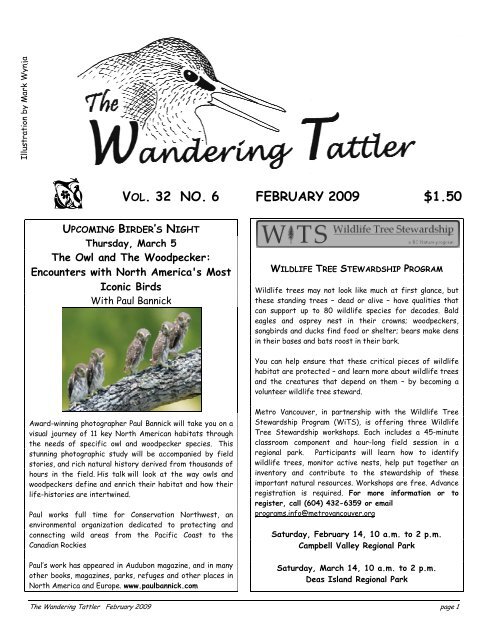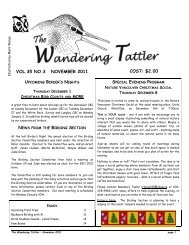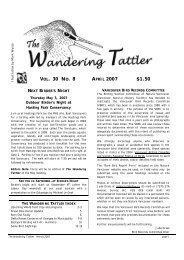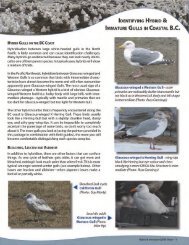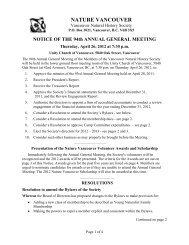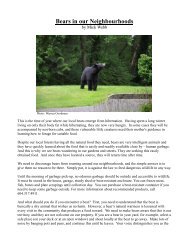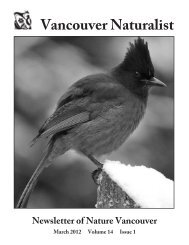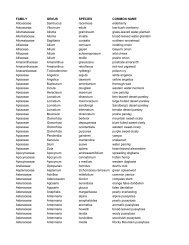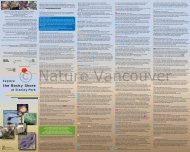Wandering Tattler - February 2009.pdf - Nature Vancouver
Wandering Tattler - February 2009.pdf - Nature Vancouver
Wandering Tattler - February 2009.pdf - Nature Vancouver
You also want an ePaper? Increase the reach of your titles
YUMPU automatically turns print PDFs into web optimized ePapers that Google loves.
Illustration by Mark Wynja<br />
VOL. 32 NO. 6 FEBRUARY 2009<br />
$1.50<br />
UPCOMING BIRDER’S NIGHT<br />
Thursday, March 5<br />
The Owl and The Woodpecker:<br />
Encounters with North America's Most<br />
Iconic Birds<br />
With Paul Bannick<br />
WILDLIFE TREE STEWARDSHIP<br />
PROGRAM<br />
Wildlife trees may not look like much at first glance, but<br />
these standing trees – dead or alive – have qualities that<br />
can support up to 80 wildlife species for decades. Bald<br />
eagles and osprey nest in their crowns; woodpeckers,<br />
songbirds and ducks find food or shelter; bears make dens<br />
in their bases and bats roost in their bark.<br />
You can help ensure that these critical pieces of wildlife<br />
habitat are protected – and learn more about wildlife trees<br />
and the creatures that depend on them – by becoming a<br />
volunteer wildlife tree steward.<br />
Award-winning winning photographer Paul Bannick will take you on a<br />
visual journey of 11 key North American habitats through<br />
the needs of specific owl and woodpecker species. This<br />
stunning photographic study will be accompanied by field<br />
stories, and rich natural history derived from thousands of<br />
hours in the field. His talk will look at the way owls and<br />
woodpeckers define and enrich their habitat and how their<br />
life-histories are intertwined.<br />
Paul works full time for Conservation Northwest, an<br />
environmental organization dedicated to protecting and<br />
connecting wild areas from the Pacific Coast to the<br />
Canadian Rockies<br />
Paul’s work has appeared in Audubon magazine, and in many<br />
other books, magazines, parks, refuges and other places in<br />
North America and Europe. www.paulbannick.com<br />
Metro <strong>Vancouver</strong>, in partnership with the Wildlife Tree<br />
Stewardship Program (WiTS), is offering three Wildlife<br />
Tree Stewardship workshops. Each includes a 45-minute<br />
classroom component and hour-long field session in a<br />
regional park.<br />
Participants will learn how to identify<br />
wildlife trees, monitor active nests, help put together an<br />
inventory and contribute to the stewardship of these<br />
important natural resources. Workshops are free. Advance<br />
registration is required. For more information or to<br />
register, call (604) 432-6359 or email<br />
programs.info@metrovancouver.org<br />
Saturday, <strong>February</strong> 14, 10 a.m. to 2 p.m.<br />
Campbell Valley Regional Park<br />
Saturday, March 14, 10 a.m. to 2 p.m.<br />
Deas Island Regional Park<br />
The <strong>Wandering</strong> <strong>Tattler</strong> <strong>February</strong> 2009<br />
page 1
NATURE VANCOUVER EVENING PROGRAM<br />
THURSDAY, FEBRUARY 26<br />
7:30PM<br />
TEXAS: A NATURAL HISTORY<br />
WITH RON LONG<br />
FEBRUARY<br />
BIRD FIELD TRIPS…AND OTHERS…<br />
NOTE: There are more birding trips listed on the<br />
website than are in the Winter <strong>Vancouver</strong> Naturalist. **<br />
Colony Farm Regional Park, Coquitlam<br />
<strong>February</strong> 7<br />
Colony Farm in winter can provide interesting birding. The<br />
Farm is home to many over wintering raptors, sparrows,<br />
shrike and waterfowl. Join leader Larry Cowan for a halfday<br />
outing. Meet the leader at the parking area at the east<br />
end of Colony Farm Rd. in Coquitlam at 9:00am. 604-465-<br />
1402<br />
Birding at Reifel Migratory Bird Sanctuary, Delta<br />
<strong>February</strong> 15<br />
Join John Chandler for a half-day birding trip to Reifel<br />
Migratory Bird Sanctuary in Ladner. We will be looking for<br />
Snow Geese, swans and other waterfowl and raptors.<br />
Remember to bring some money for the small admission fee<br />
and dress for chilly and/or wet weather. You may want to<br />
bring your lunch and a hot drink to enjoy in the warming hut<br />
after your walk. Meet John at the Reifel gift shop at<br />
9:00am. Contact John at 604-274-4117.<br />
** Jericho Park, <strong>Vancouver</strong><br />
<strong>February</strong> 21<br />
Look for unusual ducks and spring arrivals. Meet in East<br />
Parking lot at 8:00am. Contact Adrian Grant Duff 604-263-<br />
7957.<br />
** Queen Elizabeth Park, <strong>Vancouver</strong><br />
<strong>February</strong> 28<br />
Look for early migrants and species discovered on recent<br />
surveys. Meet Adrian Grant Duff 604-263-7957 at 8:00am<br />
in front of Entrance to Pitch and Putt Golf Course, north of<br />
tennis courts, Queen Elizabeth Park.<br />
THE WANDERING TATTLER INDEX<br />
Great Backyard Bird Count 5<br />
Bird Studies Canada Latest News 6<br />
Backyard Birding with Al 6<br />
Birding Section Committee Meeting Minutes 7<br />
Natural Selection…..changing faster… 10<br />
Rare Bird Alert Sightings for August 2008 12<br />
The size of Texas is legendary but with size comes<br />
diversity and for the naturalist it is this diversity that is<br />
truly astonishing. Habitats range from the lush, well<br />
watered Hill Country to the absolute desert of the Big<br />
Bend of the Rio Grande to the mild year round climate of<br />
the Gulf Coast. Within these habitats the variety of birds,<br />
animals, and especially plants seems never ending. This talk<br />
will take a long look at the marvellous natural history of<br />
this the largest of the Lower 48.<br />
OTHER EVENTS FOR BIRDER’S<br />
MAPLEWOOD FLATS CONSERVATION AREA<br />
All levels of birders are welcome to join the Wild Bird<br />
Trust’s monthly bird survey of Maplewood Flats<br />
Conservation Area, North <strong>Vancouver</strong>. This survey is<br />
conducted on the first Saturday of each month. Meet at<br />
0800 in the parking lot of the Pacific Environment Science<br />
Centre, 2645 Dollarton Highway. If the gate is closed, park<br />
adjacent to the highway. For details, please contact Janice<br />
Wilson, Bird Survey Coordinator at 604-987-5586. On the<br />
second Saturday of each month, you’re welcome to join the<br />
Wild Bird Trust’s <strong>Nature</strong> Walks with Al Grass at<br />
Maplewood Flats Conservation Area. Meet at 1000 in the<br />
parking lot of the Pacific Environment Science Centre,<br />
2645 Dollarton Highway. If the gate is closed, park<br />
adjacent to the highway.<br />
HASTINGS PARK SANCTUARY<br />
Members of the Hastings Park Conservancy’s Environmental<br />
Committee and guest naturalists lead nature walks through<br />
the Sanctuary in Hastings Park. In winter/spring 2009, the<br />
walks will be held on the fourth Saturday of each month,<br />
starting at 0900. All walks leave from the northeast<br />
corner of the Sanctuary (near the red barns and the<br />
Playland restrooms). There’s free parking on site for<br />
visitors to the Sanctuary, or take the bus to Hastings &<br />
Renfrew Streets. For further information, contact Pat<br />
Miller at 604-294-1272.<br />
REIFEL BIRD SANCTUARY<br />
Every Sunday, enjoy a bird walk with John Ireland at Reifel<br />
Bird Sanctuary in Delta. Meet at the reception area at<br />
1000. Reifel’s admission fee is $4.00 for adults and $2.00<br />
for children (2-14) and seniors (60+). Phone 604-946-6980<br />
for more information.<br />
The <strong>Wandering</strong> <strong>Tattler</strong> <strong>February</strong> 2009 page 2
SQUAMISH ESTUARY<br />
Squamish estuary monthly bird counts are held on the first<br />
or second Sunday of each month, depending on the tide. For<br />
these half-day counts, meet at 0700 (April to September)<br />
or at 0800 (October to March) at the Howe Sound Inn and<br />
Brew Pub at the end of Cleveland Avenue in downtown<br />
Squamish. All levels of birders are welcome to participate.<br />
The count usually lasts until 1300, at which time we meet<br />
back at the Brew Pub for lunch. For more information,<br />
contact Judith Vetsch at 1-604-892-3340.<br />
STANLEY PARK ECOLOGY SOCIETY (SPES)<br />
Discovery Walks are two-hour guided walking tours with a<br />
naturalist or local expert, leaving from the Lost Lagoon<br />
<strong>Nature</strong> House on the south-east shore of Lost Lagoon.<br />
Explore the natural and cultural history of Stanley Park.<br />
Rain or shine. Walk themes and leaders vary. $10 public, $5<br />
members and under 18. Pre-registration is recommended.<br />
Contact: Public Programs Manager: 604-257-8544.<br />
Calendar: www.stanleyparkecology.ca<br />
Birding in Stanley Park: Join naturalist Catherine<br />
Aitchison for a two-hour walk in Stanley Park to identify<br />
migratory and resident birds and learn bird-watching skills.<br />
Meet at the Lost Lagoon <strong>Nature</strong> House at 0900 on the last<br />
Sunday of every month. Fee by donation.<br />
TERRA NOVA NATURAL AREA<br />
On the third Saturday of each month, anyone interested in<br />
birds is welcome to join the <strong>Nature</strong> <strong>Vancouver</strong>’s monthly<br />
bird survey of the Terra Nova Natural Area in Richmond.<br />
Meet in the Terra Nova parking lot at 0800 (October-<br />
March) or 0700 (April-September). For details please<br />
contact the co-ordinator, Eric Greenwood at 604-737-<br />
4724. The <strong>Nature</strong> Reserve is reached by driving west on<br />
Westminster Highway past No.1 Road, and following it<br />
through the Terra Nova residential area.<br />
BIRD SURVEYS AT UBC FARM<br />
Every third Sunday of each month, join in a bird survey at<br />
the UBC Farm. Meet at 8am (March to August) and 9am<br />
(September to <strong>February</strong>) at the main gate to the farm. The<br />
farm is located on the UBC south campus off Westbrook<br />
between 16th and Southwest Marine Drive. Directions to<br />
the farm can be found at:<br />
http://www.landfood.ubc.ca/ubcfarm/contact.php.<br />
The farm is normally locked on Sunday but the group has a<br />
key. Currently the key is held by Sue Kay-Downs (604-<br />
569-3058). As the holder of the key, Sue is our leader,<br />
contact person and scribe. The survey is very informal,<br />
experts and beginners are all welcome to help and learn.<br />
The gate has to be closed again once we start so<br />
punctuality is helpful.<br />
MARK YOUR CALENDARS NOW….<br />
BRANT WILDLIFE FESTIVAL<br />
IN PARKSVILLE, QUALICUM BEACH AND NANAIMO<br />
BIG DAY BIRDING<br />
SATURDAY, APRIL 4<br />
Counting: 5 a.m. to 3 p.m.<br />
Post-count gathering 3:30 p.m. to 5:30 p.m.<br />
$20 per person<br />
MORE details in March edition or on their website…….<br />
EBIRD – NEW MAPPING TOOL<br />
I just noticed that eBird has a brand new mapping tool for<br />
exploring bird records in the database. If you look for<br />
records of a certain species from a province, for instance,<br />
instead of the old provincial maps with green dots, you get<br />
a Google Maps interface that allows you to zoom in as close<br />
as you like. Then if you click on a location dot, all the<br />
records for that species at that location are displayed.<br />
Very cool.<br />
You can easily check this out by clicking on one of the<br />
provinces on the right hand side of the home page<br />
(www.ebird.ca). That will display a bar graph checklist for<br />
the province based on eBird records, then click on any<br />
species you like.<br />
Dick Cannings<br />
Naramata, BC<br />
WESTERN HUMMINGBIRD PROJECT<br />
- NEW PROGRAM<br />
The US Forest Service and the Hummingbird Monitoring<br />
Network (HMN) are pleased to announce a new “Wings over<br />
the Americas” program—the Western Hummingbird<br />
Project. Attached is the announcement of the program. A<br />
kick-off workshop will be held April 16-18, 2009 in Tucson,<br />
Arizona, in conjunction with the Cooper Ornithological<br />
Society’s annual meeting. We hope many of you will be able<br />
to attend. April 16 is the primary workshop day; the<br />
preliminary agenda is included in the attached program<br />
announcement.<br />
During this time, the Partners In Flight Western Working<br />
Group is holding its meeting in British Columbia where the<br />
Rufous Hummingbird, a PIF species of continental concern,<br />
breeds. We apologize for this conflict but hope it is an<br />
opportunity to investigate hummingbird conservation issues<br />
in Canada.<br />
Our goal is to bring focus on hummingbird conservation<br />
through effective collaborations. If you are interested in<br />
participating or have suggestions on improving the WHP<br />
workshop, etc., please let us know your ideas by contacting<br />
Susan Wethington at swething@dakotacom.net.<br />
The <strong>Wandering</strong> <strong>Tattler</strong> <strong>February</strong> 2009 page 3
A YEAR ROUND PROGRAM<br />
Please check the website for<br />
ALL the WINTER Events at<br />
www.birdsonthebay.ca<br />
Walks, events, programs<br />
For the whole family<br />
Saturday <strong>February</strong> 21 9 am – 11 am<br />
Bird Walk at Mud Bay Park<br />
Discover the birds that make Mud Bay Park home with<br />
naturalist Lynn Pollard. This park features tidal marshes &<br />
eelgrass beds. Bring binoculars and field guide if you have<br />
them. Wear comfortable waterproof foot wear, dress<br />
warmly. Walk will go rain or shine. Meet: Mud Bay Park<br />
parking lot, 127A St & Colebrook Rd. (watch for signs)<br />
Host: Surrey Parks Cost: Free. Info: (604) 501-5158<br />
Saturday <strong>February</strong> 21 7pm – 9pm<br />
Owl Prowl<br />
Join renowned birder Al Grass for an evening with the owls<br />
in Stanley Park. An indoor presentation will be followed by<br />
a walk to Beaver Lake to listen for these secretive and<br />
nocturnal creatures. Meet: Stanley Park Dining Pavilion<br />
Host: Stanley Park Ecology Society Cost: by donation Reg<br />
& Info: (604) 681-9453<br />
Friday <strong>February</strong> 27 7pm - 9pm<br />
Whooo is Home? Looking for Owls<br />
Find out what species of owls live in the Fraser Valley<br />
through an illustrated talk, and then go on a walk through<br />
the forest to see whoo is home. Bring small flashlight.<br />
Wear comfortable waterproof foot wear, dress warmly.<br />
Walk will go rain or shine. Leaders: Roy Thomson, Al and<br />
Jude Grass. Audience: 8 and older. Registration required.<br />
Host: Semiahmoo Fish and Game Club Meet: Little Campbell<br />
Hatchery – 1284 184 th Street (between 16 th & 8 th Ave),<br />
Surrey Reg & Info: 604-538-8774<br />
Saturday <strong>February</strong> 28<br />
Cleaning and Repairing Nest Boxes at Burnaby Lake<br />
Regional Park Meet: <strong>Nature</strong> House on Piper Avenue, off<br />
Winston. Hosts: Burnaby Lake Park Association, Metro<br />
<strong>Vancouver</strong> Regional Parks. Cost: Free Info: (604) 520-<br />
6442.<br />
THE FUN OF ATLASSING<br />
The first year of the BC Breeding Bird Atlas has been a<br />
whirlwind of activity and a great success – thanks to you!<br />
Over 800 participants have entered data for more than<br />
280 species in over 930 – 10 km squares. The Birding<br />
Stories on the web site and emails we have received are a<br />
taste of the fun you are having. Dave Fraser said he hasn’t<br />
had so much fun birding in years. George Clulow told us how<br />
it had gotten him to explore new areas and make new<br />
discoveries (check out his Industrial Strength Herons on<br />
the atlas web site). We also heard from many of you on how<br />
difficult it was to access point count locations.<br />
We owe a great deal of our success to the Regional<br />
coordinators who volunteered their time to coordinate atlas<br />
efforts in 41 regions of the province. They are the<br />
backbone of the program. We also acknowledge the<br />
Herculean effort by the Atlas Steering and Technical<br />
committees and partners who nurtured the project from a<br />
germ of an idea to a fully fledged project in just a few<br />
months. And of course, you, the birders did a fabulous job<br />
doing what you enjoy - birding.<br />
One of the beauties of today’s atlassing is the ease by<br />
which data can be entered and displayed on the web. The<br />
BSC team of Denis LePage, Andrew Couturier and Ron<br />
Ridout in Ontario devoted their efforts to getting the<br />
program on line in timely fashion.<br />
All of this great work requires funding and so many<br />
organizations and companies stepped forward. We have<br />
gone from being penniless to raising over $330,000, in little<br />
over a year, and secured some very significant long-term<br />
funding commitments through to 2014. Much fundraising<br />
remains to be done, but we have a solid platform to build<br />
on.<br />
One last point – any field notes you took on trips last<br />
summer might have some valuable information for the atlas<br />
that you can add over the coming months.<br />
Rob Butler - BC Breeding Bird Atlas Coordinator<br />
Contact us<br />
BC Breeding Bird Atlas - Bird Studies Canada<br />
5421 Robertson Road Delta, BC V4K 3N2<br />
1-877-592-8527<br />
The <strong>Wandering</strong> <strong>Tattler</strong> <strong>February</strong> 2009 page 4
The Great Backyard Bird Count is made possible, in part, by<br />
support from Wild Birds Unlimited.<br />
The Cornell Lab of Ornithology is a non profit membership<br />
institution interpreting and conserving the earth’s biological<br />
diversity through research, education, and citizen science<br />
focused on birds. www.birds.cornell.ed<br />
COUNT FOR FUN,<br />
COUNT FOR THE FUTURE<br />
New York, NY and Ithaca, NY-Bird and nature fans<br />
throughout North America are invited to join tens of<br />
thousands of bird watchers for the 12 th annual Great<br />
Backyard Bird Count (GBBC), <strong>February</strong> 13-16, 2009.<br />
A joint project of the Cornell Lab of Ornithology and the<br />
National Audubon Society, this free event is an opportunity<br />
for families, students, and people of all ages to discover<br />
the wonders of nature in backyards, schoolyards, and local<br />
parks, and, at the same time, make an important<br />
contribution to conservation.<br />
“Anyone who can identify even a few species can contribute<br />
to the body of knowledge that is used to inform<br />
conservation efforts to protect birds and biodiversity,”<br />
said Audubon Education Vice-President, Judy Braus.<br />
Volunteers take part by counting birds for at least 15<br />
minutes on one or more days of the event and reporting<br />
their sightings online at www.birdcount.org. The data help<br />
researchers understand bird population trends across the<br />
continent, information that is critical for effective<br />
conservation. In 2008, participants submitted more than<br />
85,000 checklists, a new record.<br />
“The GBBC has become a vital link in the arsenal of<br />
continent wide bird-monitoring projects,” said Cornell Lab<br />
of Ornithology director John Fitzpatrick. “With more than<br />
a decade of data now in hand, the GBBC has documented<br />
striking changes in late-winter bird distributions.”<br />
Participants submit thousands of digital images for the<br />
GBBC photo contest each year. Last year’s winners have<br />
been chosen and are now posted on the web site.<br />
Participants are also invited to upload their bird videos to<br />
YouTube tagged “GBBC.” Some of them will also be<br />
featured on the GBBC web site. All participants will be<br />
entered in a drawing to win dozens of birding items,<br />
including stuffed birds, clocks, books, feeders, and more.<br />
Businesses, schools, nature clubs, Scout troops, and other<br />
community organizations interested in the GBBC can<br />
contact the Cornell Lab of Ornithology at (800) 843-2473<br />
(outside the U.S., call (607) 254-2473), or Audubon at<br />
citizenscience@audubon.org or (215) 355-9588, Ext 16.<br />
Audubon is dedicated to protecting birds and other wildlife<br />
and the habitat that supports them. Our national network<br />
of community-based nature centres and chapters, scientific<br />
and educational programs, and advocacy on behalf of areas<br />
sustaining important bird populations, engage millions of<br />
people of all ages and backgrounds in conservation.<br />
www.audubon.org<br />
VANCOUVER AVIAN RESEARCH CENTRE’S<br />
2009 SPRING WORKSHOPS<br />
We’re very pleased to announce that the <strong>Vancouver</strong> Avian<br />
Research Centre’s 2009 spring workshops schedule has just<br />
been posted.<br />
This year the Centre is offering two courses:<br />
BIRD BANDING & MONITORING WORKSHOP<br />
Following the success of our banding workshops last year<br />
we will again be offering our 3 day action-packed<br />
introductory course consisting of presentations, specimen<br />
study, field mist-netting, banding, and processing under the<br />
direction of Derek Matthews, Master Bander and Banderin-charge<br />
at the <strong>Vancouver</strong> Avian Research Centre.<br />
The workshop has been developed for people with little or<br />
no bird banding or bird in the hand experience and provides<br />
a fantastic opportunity to see birds up close and personal,<br />
to learn about their plumages, molt sequences, and life<br />
habits.<br />
BIRD IDENTIFICATION WORKSHOP<br />
This new course for 2009 has been developed for birders<br />
who wish to take their bird knowledge and identification<br />
skills to the next level. Although designed for beginner and<br />
intermediate birders the ornithological aspects of the<br />
course would benefit even advanced and expert birders.<br />
Full details of the courses, schedules, dates and<br />
registration information can be found online by contacting:<br />
http://www.birdvancouver.com/workshops.html<br />
The <strong>Wandering</strong> <strong>Tattler</strong> <strong>February</strong> 2009 page 5
BACKYARD BIRDING WITH AL<br />
ABOUT THRUSHES<br />
BIRD STUDIES CANADA<br />
LATEST NEWS<br />
AVIBASE IS A HIT, 50 MILLION TIMES OVER!<br />
5 January 2009 – Avibase, an extremely popular resource<br />
hosted by Bird Studies Canada and maintained by BSC’s<br />
senior scientist Denis Lepage, has just received its 50<br />
millionth individual hit. The Avibase website offers bird<br />
checklists for any region of the world, using a variety of<br />
options such as common names in over a dozen languages. It<br />
also provides taxonomic information, images, and sounds for<br />
all species and subspecies of the world’s birds.<br />
http://avibase.birdscanada.org/<br />
One question that often arises, especially during snow<br />
events, is “What can I do to help the Thrushes, especially<br />
Varied Thrush and robins? Both are great consumers of<br />
fruits, but the Varied Thrush has more versatile feeding<br />
habits. Chopped apples and plumped raisins (soaked in hot<br />
water) are favourites of both. I know of backyard bird<br />
feeders who freeze rowan (European Mountain-ash) fruit,<br />
blackberries, and blueberries, and leave the thawed out<br />
fruit for the birds in winter. Apparently this is a big hit<br />
with thrushes, and even waxwings.<br />
EBIRD CANADA RECEIVES $20,000 GRANT<br />
20 January 2009 – Bird Studies Canada has received a<br />
grant of $20,000 from a family foundation to fund eBird<br />
Canada, the popular online birding database. eBird Canada<br />
use has been growing exponentially since the website was<br />
launched in the fall of 2006. Birders can enter their<br />
sightings into the database, and then explore the database<br />
with maps, seasonal graphs, or tables. eBird also acts as<br />
listing software, so can keep track of birders’ life lists for<br />
different regions. You can enter or explore data from<br />
anywhere in the Americas, and New Zealand was recently<br />
added to the eBird ‘family.’ There are now over 167,000<br />
Canadian checklists in eBird, representing well over a million<br />
bird species records. All the eBird data becomes part of a<br />
larger database at the Avian Knowledge Network. The data<br />
can be downloaded through our <strong>Nature</strong>Counts portal, where<br />
we also provide ways to explore and visualize the bird data.<br />
You can check out eBird at www.ebird.ca; it’s free, it’s<br />
informative, and it’s fun!<br />
NEW ISSUE OF AVIAN CONSERVATION AND ECOLOGY<br />
NOW AVAILABLE<br />
7 January 2009 – The latest issue of Avian Conservation<br />
and Ecology – Écologie et Conservation des Oiseaux (ACE-<br />
ÉCO), Volume 3, Issue 2, December 2008, has been<br />
published. This open-access, fully electronic scientific<br />
journal is sponsored by the Society of Canadian<br />
Ornithologists and Bird Studies Canada. To browse the<br />
table of contents or read a variety of new articles, visit the<br />
ACE-ÉCO website.<br />
Varied Thrush<br />
Photo: Jude Grass©<br />
The Varied Thrush will also take a variety of seeds with<br />
white millet being a favourite. Varied Thrushes at our<br />
feeder also enjoy roasted peanut pieces and sunflower<br />
chips (chopped premium oil sunflower seeds).<br />
Varied Thrushes are quite shy so putting the fruits, nuts<br />
and seeds near or under a hedge or some other shelter is a<br />
good idea.<br />
Enjoy your birds.<br />
Al Grass<br />
EIGHT RECOVERY STRATEGIES RECENTLY POSTED<br />
BY BC MINISTRY OF ENVIRONMENT<br />
The following 8 Recovery Strategies have been posted on<br />
the MOE recovery planning website:<br />
Recovery Strategy for<br />
<strong>Vancouver</strong> Island Marmot; Lyall’s mariposa lily; rusty cord<br />
moss ; Branched Phacelia; Dromedary-jumping Slug; Badger<br />
Pallid Bat; Behr’s Hairstreak<br />
http://www.env.gov.bc.ca/wld/recoveryplans/rcvry1.htm<br />
The <strong>Wandering</strong> <strong>Tattler</strong> <strong>February</strong> 2009 page 6
VNHS BIRDING SECTION COMMITTEE<br />
MINUTES OF THE MEETING ON<br />
TUESDAY NOVEMBER 18, 2008<br />
Present: Jude grass (Chair), Martin McNicholl, Mike Fung<br />
and June Ryder (recorder).<br />
Regrets: Adrian Grant Duff, Wayne Weber, David Boyd.<br />
Welcome<br />
1. Adoption of agenda with additions<br />
Motion: Moved: Martin Seconded: Mike, Carried.<br />
2. Approval of the Minutes of May 30, 2008<br />
Moved: Mike seconded: Jude motion, Carried.<br />
3. Birding Section Committee – Election of Chair<br />
Motion: Moved by Martin that we re-elect Jude;<br />
seconded Mike; Carried unanimously.<br />
4. Birder’s Night<br />
Programs<br />
Dec 4<br />
Chair – Martin Program: <strong>Vancouver</strong> CBC – final<br />
details: Adrian and Peter Candido - bird id.<br />
presentation; Jude will ask Peter, suggests id. tips for<br />
ducks, mergansers, grebes, etc. (count day details<br />
covered under #5 below). Speaker (short talk) Simon<br />
Robinson? Ladner: Dec 21 - Jude; White Rock: Dec 28<br />
– Viveka Ohman.<br />
2009: Jan 8 (note: not Thur. the 1st; 8 th will coincide<br />
with Marine Biology Section)<br />
Chair: Jude Speaker: Roger Emsley, from APE<br />
(Against Port Expansion) - Delta Port.<br />
Feb 5<br />
Chair: Martin Speaker: Dr. Sean Boyd, CWS – New<br />
Details on the Barrow’s Goldeneye.<br />
March 5<br />
Chair: Jude. Speaker: Paul Bannick (photographer and<br />
naturalist, Seattle) – The Owl and the Woodpecker.<br />
April 2<br />
Chair: Martin Speakers: Rob Butler – short feature<br />
re BC Breeding Bird Atlas & Ken Hall – Birds of the<br />
South Okanagan<br />
May 7<br />
Chair: Jude Location: outdoors: possibilities Queen<br />
Elizabeth Park or UBC Farm – finalize at next mtg.<br />
• Educational segments – Christine Bishop has<br />
volunteered.-<br />
• Conservation Issues – June<br />
• Refreshments: Mike – June will organize refreshments<br />
until May ’09. At the Dec. meeting, we should ask for<br />
volunteers to sign up to bring cookies or other finger<br />
food; and we should assess the interest in coffee – and<br />
if high, seek a volunteer to look after this until May ’09.<br />
• Future Speaker suggestions – hold for fall 2009<br />
Vince Beier - Mountain View Conservation Society –<br />
breeding Spotted Owls<br />
Kym Welstead - MOE on SAR, South Coast<br />
Conservation,<br />
Colin Clark – Birds of Madagascar.<br />
5 <strong>Vancouver</strong> Christmas Bird Count – December 14<br />
a) Participants, Dinner (Adrian will collect money -<br />
$7)<br />
b) Post-count tally: (Danny Tyson)<br />
c) Entertainment: - Quiz: verbal - Martin; bird songs<br />
Brian Self; slides – Jude, Peter Candido. Jude to<br />
ask Brian and Peter.<br />
6 Section and Committee Updates<br />
a) Birding Section Field Trips – Adrian<br />
We are trying to find more people to lead birding<br />
trips.<br />
b) Bird Alert – Wayne (no report)<br />
c) <strong>Vancouver</strong> Bird Records Committee – Jude has<br />
arranged meeting for Saturday Jan 31; location<br />
TBC.<br />
d) <strong>Wandering</strong> <strong>Tattler</strong> – Jude: We need more writ-ups<br />
from our members about interesting sightings,<br />
observations of bird behaviour, etc; all field trips<br />
should be written up, but not necessarily by the<br />
leader.<br />
e) Raptor Surveys – Jude: We need funding to<br />
support data entry, and also to set up an automatic<br />
(computerized) data-entry system; wee need to<br />
discuss possibilities for the future of the raptor<br />
surveys..<br />
f) Golf Course Surveys – David (no report)<br />
g) The Birder’s Guide to <strong>Vancouver</strong> and the Lower<br />
Mainland - minor correction and reprint: Jude will<br />
contact Cathy Aitchison to ascertain progress.<br />
Jeremy has the original materials. Publisher<br />
(Harbour) is the same as for <strong>Nature</strong> In <strong>Vancouver</strong>.<br />
h) <strong>Nature</strong> in <strong>Vancouver</strong> – should be out by early<br />
spring (Earth Day?) currently the publisher is<br />
doing the layout.<br />
i) <strong>Nature</strong> <strong>Vancouver</strong> Website – Birder’s section:<br />
descriptions are being added for birding sites.<br />
j) Bird Workshops and Symposium - (see 7b)<br />
k) Revised Bird Checklist for Metro <strong>Vancouver</strong>– (has<br />
been circulated by Wayne W.)<br />
l) Breeding Birds and Invasive Removal Strategy: –<br />
Committee has drafted a preliminary strategy;<br />
discussion continues.<br />
m) Provincial Bird Records Committee - Martin: The<br />
initial meting to discuss the BC checklist was held<br />
22 April, 2007; the first formal meeting was held<br />
18 Oct. 2008, in Sidney, with chair: M. Preston,<br />
secretary: T. Greenfield, and members W.<br />
Campbell and M. McNicholl. Committee structure<br />
was discussed, and the relations between PBRC and<br />
The <strong>Wandering</strong> <strong>Tattler</strong> <strong>February</strong> 2009 page 7
The Biodiversity Centre for Wildlife Studies. It<br />
was agreed that PBRC should maintain the official<br />
list of birds of BC. Composition of PRBC should be<br />
5 or 7 individuals who are representative of<br />
member groups; also invite current (or previous)<br />
ed. of BC section of N. American Birds (now Don<br />
Cecile). Also include regional representative for<br />
any part of the province not already represented,<br />
e.g., Mark Phinney for Peace River area.<br />
Constitution and rules to be based on those of<br />
Alberta bird records committee. Results to be<br />
published in Wildlife Afield, from which other<br />
groups can extract material with appropriate<br />
acknowledgement. Committee needs to set up a<br />
process for establishing the checklist, aiming for<br />
publication of first official report in Oct. 2009.<br />
Also, need to carefully define working relations and<br />
division of responsibilities between PBRC and more<br />
local bird records committees (<strong>Vancouver</strong>,<br />
Victoria). Propose to publicize and promote the<br />
work of the PBRC by placing a colour insert in<br />
various bird-related magazines, e.g., W. <strong>Tattler</strong> and<br />
BC Birding Motion by Martin: That the Birding<br />
Section contributes $300 from its Publication<br />
Fund toward the cost of a colour insert that<br />
promotes reporting of rare birds to Provincial Bird<br />
Records Committee. Seconded: Mike; Carried.<br />
7. New Business<br />
a) Letter from Jeremy re. Birding Section<br />
publication fund and other matters (previously<br />
circulated by email). Jude to write a brief reply.<br />
b) Raptor Identification Workshops with William<br />
Clark – 2 workshops on raptor field identification<br />
are being offered: Jan 9 – 11 (introductory level)<br />
and Jan 24 – 25 (advanced); $150 each; at Reifel.<br />
These will be supported and promoted by Birding<br />
Section Committee. Other partners: BC Waterfowl<br />
Soc., (TBC), BC Field Ornithologists ((TBC), and BC<br />
Breeding Bird Atlas, (and others?).<br />
8. Information Items<br />
a) BC Breeding Bird Atlas – Technical Committee &<br />
Steering Committee reports<br />
b) Birds on the Bay – looking for Birders to assist<br />
with walks….<br />
c) Biodiversity Centre for Wildlife Studies – AGM<br />
Saturday November 29 at 12 noon at Reifel<br />
Migratory Bird Sanctuary Museum.<br />
9. VNHS Board and Society Information Items<br />
Date and location of next meeting<br />
January TBC<br />
SNOWY OWLS SWOOP SOUTHWARD,<br />
DELIGHTING BIRDERS<br />
EDITOR’S NOTE: BUT NOT HERE!!!<br />
Biologists say an increase in snowy owl sightings in the<br />
South suggests that the arctic species did so well in its<br />
northern breeding grounds last year that competition is<br />
driving the young ones to warmer climates.<br />
Snowy Owl Al Grass ©<br />
The mostly white owls of "Harry Potter" fame are spotted<br />
in small numbers in upstate New York and other northern<br />
states every winter. This year, they've also been spotted<br />
farther south, in states where they're rarely seen.<br />
In Tennessee, birders armed with spotting scopes and<br />
telephoto lenses scrambled from as far away as Georgia<br />
and Alabama to see the first snowy owl reported in that<br />
state in 22 years.<br />
The owl showed up in early December in the fields<br />
surrounding a General Motors plant in Spring Hill,<br />
Tennessee. Sightings were still being posted on the<br />
Tennessee Ornithological Society's Web site in late<br />
January.<br />
Birding hot lines lit up in northern Virginia with the sighting<br />
of a young male snowy owl in early December. The bird later<br />
died after it was found, sick and weak, and brought to the<br />
Wildlife Centre of Virginia in Waynesboro.<br />
Rarely seen south of northern Ohio, snowy owls have also<br />
been reported this year in Kansas and Missouri, according<br />
to the eBird.org national bird reporting Web site.<br />
Snowy owls nest on the ground in the Arctic tundra and<br />
many of them stay there year-round, while some winter in<br />
Canada and the northern United States. They tend to show<br />
up in greater numbers in the U.S. every three to five years,<br />
pushed by crashes in the population of lemmings, the<br />
hamster-like mainstay of their diet.<br />
But that doesn't appear to be the reason for this year's<br />
influx.<br />
The <strong>Wandering</strong> <strong>Tattler</strong> <strong>February</strong> 2009 page 8
"This year it appears the lemming population was really<br />
good," said Laura Erickson, a biologist at the Cornell Lab of<br />
Ornithology in Ithaca. "When lemmings are abundant, snowy<br />
owls have a very successful breeding season."<br />
As a result, the owl population grows so large that many of<br />
the young males move farther south to stake out feeding<br />
territory. An individual adult snowy owl may eat three to<br />
five lemmings per day, or up to 1,600 per year.<br />
NEW BOOKS<br />
Snowy owls aren't uncommon in winter in Minnesota and<br />
Wisconsin, but they're far more plentiful than usual this<br />
year, Erickson said. At the airport in Minneapolis, biologists<br />
have had to trap and move snowy owls for fear they'd be<br />
sucked into a jet engine, she said.<br />
"As birds of the tundra, they're drawn to large open fields<br />
like airports," Erickson said.<br />
The increase in southerly sightings is most likely a<br />
temporary phenomenon. Back in the arctic next summer,<br />
the larger population of owls may devour so many lemmings<br />
that food scarcity will bring the owl population back down,<br />
Erickson said.<br />
Mary Esch<br />
Associated Press Writer - Seattle Times<br />
Wednesday, January 28, 2009<br />
Couzens, Dominic. Top 100 Birding Sites of the<br />
World. 2008. University of California Press. Hardbound:<br />
320 pages. Price: $45.00 U.S. SUMMARY: This coffee<br />
table book describes the 100 best birding sites on the<br />
planet. The bird photography highlights this book Blomdahl,<br />
Anders, Bertil Breife and Niklas Holmstrom.<br />
OBSERVING BIRDS<br />
RIVER OTTER EATING A DUCK<br />
I wandered in the fog through Bob Heirman park in<br />
Snohomish County this morning. The flood debris is an<br />
impressive testimony to the power of the water that went<br />
through here a couple weeks ago. Visibility was limited and<br />
it was as still and quiet as I have ever experienced. As I<br />
got down to the bar there was a loud splashing of water in<br />
the distance and the sound was adjacent to a large log jam.<br />
I climbed up the backside of logs as quietly as I could<br />
manage, then sort of slithered over the top and stopped<br />
with my waist over the top log and my head pointing<br />
downhill. I could hear a gnawing sound and finally saw below<br />
me was a river otter holding and ripping into the breast of a<br />
duck which after a minute or so I was able to identify as a<br />
Common Goldeneye. Unfortunately the wind shifted and the<br />
otter caught my scent, stood up and looked right at me,<br />
although I am not sure it actually could see me, but without<br />
a sound it slid into the water with its prize and out of my<br />
view.<br />
Later on the hike out I had 4 swans materialize out of the<br />
fog and fly right over my head, maybe only 10 feet off the<br />
ground. I could hear and feel the wind pumping through<br />
their wings.<br />
Rob Sandelin<br />
Naturalist, Writer, Teacher<br />
Kerlinger, Paul. How Birds Migrate (2nd edition). 2009.<br />
Stackpole Books. Paperback: 230 pages. Price: $21.95 U.S.<br />
SUMMARY: Kerlinger's introduction to the biology of bird<br />
migration has been updated. I recommend this book for<br />
beginning birders interested in learning more about bird<br />
migration<br />
Siegel, Deborah C. and Storrs L. Olson. The Birds of<br />
the Republic of Panama, Part 5: Gazetteer and<br />
Bibliography. 2008. Buteo Books. Hardbound: 516 pages.<br />
Price: $45.00 U.S. SUMMARY: This final volume of<br />
Alexander Wetmore's multi-volume work on the birds of<br />
Panama describes and locates all place names used by<br />
Wetmore and also contains a comprehensive bibliography.<br />
The <strong>Wandering</strong> <strong>Tattler</strong> <strong>February</strong> 2009 page 9
NATURAL SELECTION GIVES WAY TO HUMAN<br />
SELECTION PRACTICE OF HUNTING AND<br />
HARVESTING THE BIGGEST ANIMALS OR PLANTS<br />
IS CHANGING SPECIES MUCH FASTER THAN<br />
NATURE, RESEARCHERS FIND<br />
Humans have become "super predators," speeding up the<br />
evolution of the species they hunt and harvest at rates far<br />
above what is found in nature, according to new research,<br />
some of it conducted by Canadian biologists.<br />
The researchers believe that many recently observed<br />
changes in species, ranging from the shrinkage in the horns<br />
of bighorn sheep in the Rockies to the reduction in the size<br />
of caribou in Scandinavia, are being driven by humans.<br />
4<br />
The biologists estimate that hunting has caused such<br />
characteristics as body size and reproductive age to change<br />
at a rate that is a staggering 300 per cent above the pace<br />
that would prevail in nature. This figure is even greater<br />
than the change attributed to other human interferences,<br />
such as pollution, which was estimated to alter species 50<br />
per cent faster than what normally happens.<br />
"The implications are pretty wide and profound," said Paul<br />
Paquet, a University of Calgary biologist who dubs humans<br />
"super predators" for this outsized impact.<br />
A paper outlining the findings was posted yesterday in the<br />
online edition of Proceedings of the National Academy of<br />
Sciences.<br />
In it, Dr. Paquet and others argue that current hunting and<br />
harvesting practices are inadvertently causing dramatic<br />
changes in the behaviour and appearance of species. The<br />
reason: Humans tend to "high-grade" nature, taking out the<br />
biggest and best in a species.<br />
The approach is clearest in trophy hunting, where animals<br />
with the biggest horns or bodies are killed, while inferior<br />
ones are left. But the practice also occurs in commercial<br />
fishing, where mesh openings in nets capture the biggest<br />
fish while smaller ones escape.<br />
The human approach is the opposite to what happens in<br />
nature, where predators kill the easiest-to-catch animals,<br />
such as the young, the old and the sick, but are unable to<br />
take out the fittest adults, which then reproduce and pass<br />
their desirable characteristics on to future generations.<br />
Many hunting rules are based on a view that bagging mature<br />
animals is the best approach, but Dr. Paquet says humans<br />
should be trying to emulate nature, even though at first<br />
glance it doesn't seem sporting to kill younger creatures.<br />
"That's clearly the best management regime," he said.<br />
The researchers, who are affiliated with the University of<br />
Calgary and the University of Victoria as well as two U.S.<br />
universities, looked at 34 studies that examined physical or<br />
biological characteristics in 29 species subject to heavy<br />
pressure from human predation. Besides the bighorn sheep<br />
and caribou, they included snails; a pair of medicinal plants;<br />
and various commercially caught fish.<br />
"Harvested organisms are the fastest-changing organisms<br />
of their kind in the wild because we are super predators<br />
and we take such high proportions of a population and<br />
target the largest individuals," Dr. Paquet said.<br />
The rate of change is staggering from an evolutionary point<br />
of view, where the alteration in species is often thought to<br />
occur slowly. Alberta's bighorn sheep, for instance, have<br />
experienced a 20-per-cent drop in the length and size of<br />
their horns in only the past 30 years. The sheep are prized<br />
for the distinctive curve in their horns, making them<br />
sought-after trophies.<br />
Atlantic cod, whose populations have collapsed because of<br />
over fishing, now reproduce at an average age of five years,<br />
rather than six, as was the case previously. The change,<br />
which in humans would amount to children reaching sexual<br />
maturity and having offspring at ages of around nine to 11,<br />
occurred in only two decades.<br />
Among the species harvested or hunted by humans and<br />
reviewed in the paper, body size or horn size decreased by<br />
an average 18 per cent. There was also a pattern of<br />
reproduction at an earlier age or smaller size.<br />
THE DIMINISHING PREY<br />
BIGHORN SHEEP The sheep, found in mountainous areas<br />
of Western Canada and the United States, are famed for<br />
the unusual curved horns on the rams. The rams are hunted<br />
as trophies, but researchers believe the practice of taking<br />
the biggest specimens has prompted genetic change leading<br />
to a marked decline in horn size.<br />
CARIBOU Caribou from southern Norway, the last<br />
remaining wild population in Europe, have shrunk because of<br />
hunting. The selective killing of the biggest animals has led<br />
to a reduction in the size of bodies, antlers and jaws.<br />
Researchers suspect the same trend may have occurred in<br />
southern populations of caribou in Canada.<br />
AMERICAN GINSENG The gnarled root of the plant is<br />
prized for its medicinal properties - collected for illnesses<br />
ranging from cancer to Alzheimer's disease. But extensive<br />
harvesting has led to a change in the composition of wild<br />
stands, with an increased number of smaller, nonreproductive<br />
plants.<br />
COD The destruction of cod stocks has led to altered<br />
reproductive behaviour. The fish produce eggs at a younger<br />
age, but this early breeding has a big drawback. The early<br />
breeders are producing abnormally low numbers of eggs.<br />
Martin Mittelstaedt<br />
From Globe and Mail January 13, 2009<br />
The <strong>Wandering</strong> <strong>Tattler</strong> <strong>February</strong> 2009 page 10
THE 2008 LADNER<br />
CHRISTMAS BIRD COUNT RESULTS<br />
The 2008 Ladner CBC – originally set for December 21, was<br />
rescheduled to January 4 due to heavy snowfall and bad<br />
road conditions. While the January day wasn’t too bad, a<br />
cold, heavy wind did come up in the afternoon, and then it<br />
started snowing - big time - while we were doing the post<br />
count tally and dinner. We quickly finished up and got the<br />
birder’s heading home before the roads were too<br />
dangerous.<br />
A total of 133 species were seen on count day, plus 2<br />
species within count period. Our highlights included: a<br />
Mountain Chickadee and several Anna’s Hummingbirds which<br />
were seen at feeders in Delta: a White-throated Sparrow<br />
seen near the <strong>Vancouver</strong> Landfill. If anyone would like an<br />
electronic version of the final count tally please contact<br />
judegrass@shaw.ca.<br />
Thank you to the BC Waterfowl Society for the use of the<br />
museum for the post count gathering and to John Ireland<br />
for his assistance on count day.<br />
ATTENTION RAPTOR FANS….<br />
Jude Grass<br />
Ladner CBC Coordinator<br />
A wonderful article describing the Harlan’s Hawk has been<br />
published in the current edition of Birding the American<br />
Birding Association magazine. You can find a pdf version of<br />
the article and additional information that was not part of<br />
the printed article at the following website. The article is<br />
a must read for those who are interested in identifying<br />
Harlan’s Hawk and Red-tailed Hawks. The link is:<br />
http://aba.org/birding/v41n1p30.pdf<br />
Authored by William (Bill) Clark, who recently gave two<br />
very successful Raptor Identification courses sponsored by<br />
the Birding Section of <strong>Nature</strong> <strong>Vancouver</strong> we were actually<br />
fortunately enough to confirm a Harlan’s Hawk at McDonald<br />
Slough on Sea Island on one of the course field trips.<br />
The Stanley Park Heronry<br />
The Stanley Park Ecology Society is monitoring the heron<br />
nesting sites in Stanley Park for several organizations and<br />
studies. The provincial government’s Ministry of<br />
Environment is conducting research to determine the<br />
impact of predators and human interaction on nesting great<br />
blue herons. The data will also be forwarded to Bird<br />
Studies Canada to contribute to their national study of<br />
nesting habits and trends.<br />
See the:<br />
http://www.stanleyparkecology.ca/programs/conservation<br />
/urbanWildlife/herons/ to read the reports:<br />
1. Stanley Park Heron Colony Final Report 2008<br />
2. UBC Heron Colony 2008 Nesting Report<br />
WILD BIRDS UNLIMITED MONTHLY WALKS<br />
The following walks are offered by the Wild<br />
Bird Stores in <strong>Vancouver</strong> and North <strong>Vancouver</strong>.<br />
The next walk is Saturday <strong>February</strong> 21 to<br />
Jericho Park starting at 10 a.m. Meet in the<br />
parking lot at the west end of the park near the<br />
washroom buildings. Walks last approximately 2<br />
hours. Bring your binoculars if you have them.<br />
For more details phone 604-736-2676.<br />
The <strong>Wandering</strong> <strong>Tattler</strong> <strong>February</strong> 2009 page 11
SOME SIGHTINGS FOR VANCOUVER RARE BIRD ALERT -- AUGUST 2008<br />
SPECIES NO. DATE LOCALITY OBSERVERS<br />
American Golden Plover 1 25-Aug-08 Foot of 96th Street, Delta Ilya Povalyaev<br />
American Kestrel 1 11-Aug-08 Tsawwassen jetty, Delta Carlo Giovanella<br />
Baird's Sandpiper 2 27-Aug-08 Foot of 96th Street, Delta Mike Tabak<br />
Barred Owl 1 27-Aug-08 148th Street at 106th Avenue, Surrey Ivan Kaderabek<br />
Black and White Warbler 1 3-Aug-08 Grant Narrows, Pitt Lake Mike Newey<br />
Black Oystercatcher 7 24-Aug-08 Bird & Grebe Islets, Howe Sound Allan Milligan<br />
Black Oystercatcher several 27-Aug-08 Tsawwassen jetty, Delta Mike Tabak<br />
Black Turnstone 156 10-Aug-08 Tsawwassen ferry terminal, Delta Richard Swanston<br />
Black-bellied Plover 1800 27-Aug-08 Foot of 96th Street, Delta Mike Tabak<br />
Caspian Tern 289 26-Aug-08 Tsawwassen ferry terminal, Delta Richard Swanston<br />
Common Nighthawk 12 5-Aug-08 79th Avenue at 114th Street, North Delta Philip Kelly<br />
Common Tern 3 22-Aug-08 Maplewood Conservation Area, N <strong>Vancouver</strong> Rob Lyske<br />
Common Tern 2 29-Aug-08 Blackie Spit, Surrey Ilya Povalyaev<br />
Eastern Kingbird 3 3-Aug-08 Grant Narrows, Pitt Lake Mike Newey<br />
Eurasian Collared-Dove 3 29-Aug-08 4126 River Road, Delta Diane Kehoe<br />
Evening Grosbeak 2 12-Aug-08 Grant Narrows, Pitt Lake David Schutz<br />
Gray Catbird 3 12-Aug-08 Pitt Meadows David Schutz<br />
Gray Catbird 1 16-Aug-08 E end of 104th Ave., Surrey (nr Barnston I.) Ivan Kaderabek<br />
Greater White-fronted Goose 2 24-Aug-08 52nd Street near Hwy 17, Delta Richard Swanston<br />
Greater Yellowlegs 20 5-Aug-08 Beach Grove lagoon, Delta Richard Swanston<br />
Heermann's Gull 2 11-Aug-08 Point Roberts, WA Ilya Povalyaev<br />
Heermann's Gull 1 13-Aug-08 Wreck Beach, <strong>Vancouver</strong> Christian Lodders<br />
Heermann's Gull 1 25-Aug-08 Tsawwassen jetty, Delta Ilya Povalyaev<br />
Lazuli Bunting several 27-Aug-08 Colony Farm Park, Port Coquitlam David Schutz<br />
Lesser Goldfinch 1 - M 1-Aug-08 2093 Topaz, Abbotsford Stan Olson<br />
Lesser Goldfinch 1 - M 21-Aug-08 2093 Topaz, Abbotsford Stan Olson<br />
Lesser Yellowlegs 20 5-Aug-08 Beach Grove lagoon, Delta Richard Swanston<br />
Lincoln's Sparrow 1 27-Aug-08 Iona Island Mike Tabak<br />
Long-billed Curlew 1 3-Aug-08 Blackie Spit, Surrey Ilya Povalyaev, Ross Wood<br />
Long-billed Curlew 1 29-Aug-08 Blackie Spit, Surrey Ilya Povalyaev<br />
Long-billed Dowitcher 150 21-Aug-08 Reifel Bird Sanctuary, Delta Ilya Povalyaev<br />
Marbled Godwit 2 29-Aug-08 Blackie Spit, Surrey Ilya Povalyaev<br />
Merlin 2 24-Aug-08 400 block E 18th St., North <strong>Vancouver</strong> Larry Marchak<br />
Northern Waterthrush 1 20-Aug-08 Serpentine Fen, Surrey Mike Newey<br />
Northern Waterthrush 1 21-Aug-08 Reifel Bird Sanctuary, Delta Ilya Povalyaev<br />
Northern Waterthrush 1 23-Aug-08 Maplewood Conservation Area, N <strong>Vancouver</strong> Rob Lyske<br />
Northern Waterthrush 1 23-Aug-08 Still Creek at Sperling Ave., Burnaby Dan Peterson<br />
Olive-sided Flycatcher 1 29-Aug-08 Maplewood Conservation Area, N <strong>Vancouver</strong> Rob Lyske<br />
Parasitic Jaeger 1 2-Aug-08 Georgia Strait off Sandheads (Steveston) Richard Swanston<br />
Peregrine Falcon 2 20-Aug-08 Iona Island Mike Tabak<br />
Pomarine Jaeger 1 5-Aug-08 Foot of 96th Street, Delta Ilya Povalyaev<br />
Purple Martin 8 5-Aug-08 79th Avenue at 114th Street, North Delta Philip Kelly<br />
The <strong>Wandering</strong> <strong>Tattler</strong> <strong>February</strong> 2009 page 12
SPECIES NO. DATE<br />
Purple Martin 5 21-Aug-08<br />
Purple Martin 1 29-Aug-08<br />
Purple Martin 6 29-Aug-08<br />
Red Crossbill 25 29-Aug-08<br />
Red Knot 1 22-Aug-08<br />
Red-eyed Vireo 1 29-Aug-08<br />
Red-necked Phalarope 2 5-Aug-08<br />
Red-necked Phalarope 11 9-Aug-08<br />
Red-necked Phalarope 4 9-Aug-08<br />
Red-necked Phalarope 3 18-Aug-08<br />
Ruddy Turnstone 2 9-Aug-08<br />
Ruddy Turnstone 1 29-Aug-08<br />
Sanderling 200 19-Aug-08<br />
Sandhill Crane 5 5-Aug-08<br />
Semipalmated Sandpiper several 1-Aug-08<br />
Semipalmated Sandpiper 5 24-Aug-08<br />
Short-billed Dowitcher 25 19-Aug-08<br />
Short-billed Dowitcher 10 21-Aug-08<br />
Solitary Sandpiper 1 19-Aug-08<br />
Sooty Grouse 1 9-Aug-08<br />
Stilt Sandpiper 1 10-Aug-08<br />
Stilt Sandpiper 1 19-Aug-08<br />
Surfbird 75 24-Aug-08<br />
Turkey Vulture 7 12-Aug-08<br />
Turkey Vulture 7 16-Aug-08<br />
Western Sandpiper 6000 19-Aug-08<br />
Western Wood-Pewee 1 29-Aug-08<br />
Whimbrel several 2-Aug-08<br />
Whimbrel 1 5-Aug-08<br />
Wilson's Phalarope 4 19-Aug-08<br />
Wilson's Phalarope 4 23-Aug-08<br />
Yellow-headed Blackbird 1 3-Aug-08<br />
Yellow-headed Blackbird 1 9-Aug-08<br />
Yellow-headed Blackbird 1 12-Aug-08<br />
LOCALITY<br />
Reifel Bird Sanctuary, Delta<br />
Westminster Hwy at No. 6 Road, Richmond<br />
Maplewood Conservation Area, N <strong>Vancouver</strong><br />
Maplewood Conservation Area, N <strong>Vancouver</strong><br />
Foot of 96th Street, Delta<br />
Maplewood Conservation Area, N <strong>Vancouver</strong><br />
Beach Grove lagoon, Delta<br />
Reifel Bird Sanctuary, Delta<br />
Highway 17 pond N of Deltaport Way<br />
Foot of 96th Street, Delta<br />
Boundary Bay dyke E of 96th Street, Delta<br />
Blackie Spit, Surrey<br />
Foot of 96th Street, Delta<br />
Langley Airport, Langley<br />
Beach Grove lagoon, Delta<br />
Iona Island<br />
Foot of 96th Street, Delta<br />
Reifel Bird Sanctuary, Delta<br />
Lost Lagoon, Stanley Park, <strong>Vancouver</strong><br />
Burnaby Mountain, Burnaby<br />
Beach Grove lagoon, Delta<br />
Iona Island<br />
Bird & Grebe Islets, Howe Sound<br />
Pitt Meadows<br />
E end of 104th Ave., Surrey (nr Barnston I.)<br />
Foot of 96th Street, Delta<br />
Maplewood Conservation Area, N <strong>Vancouver</strong><br />
Tsawwassen jetty, Delta<br />
Blackie Spit, Surrey<br />
Highway 17 pond N of Deltaport Way<br />
Reifel Bird Sanctuary, Delta<br />
16th Avenue near Camosun St., <strong>Vancouver</strong><br />
Foot of 41B Street, Delta<br />
Mud Bay Park, Surrey<br />
OBSERVERS<br />
Ilya Povalyaev<br />
Julian Hudson<br />
Rob Lyske<br />
Rob Lyske<br />
Ilya Povalyaev<br />
Rob Lyske<br />
Richard Swanston<br />
Mike Tabak, John Tabak<br />
Mike Tabak, John Tabak<br />
I Povalyaev, C Giovanella<br />
Ilya Povalyaev<br />
Ilya Povalyaev<br />
Mike Tabak<br />
Ivan Kaderabek<br />
Richard Swanston<br />
George Clulow<br />
Mike Tabak<br />
Ilya Povalyaev<br />
Alan Jensen<br />
Dan Peterson<br />
Richard Swanston<br />
Rob Lyske, Mark Wynja<br />
Allan Milligan<br />
David Schutz<br />
Ivan Kaderabek<br />
Mike Tabak<br />
Rob Lyske<br />
Richard Swanston<br />
Trent Glukler<br />
Mike Tabak<br />
Trent Glukler<br />
Christine Adkins<br />
Richard Swanston<br />
Dean Smith<br />
VAN V SUN: JAN 2009<br />
The <strong>Wandering</strong> <strong>Tattler</strong> <strong>February</strong> 2009<br />
page 13
OWL<br />
ORPHANED WILDLIFE REHABILITATION<br />
SOCIETY<br />
O.W.L. Wish List<br />
A busy organization like O.W.L. is always in need of<br />
supplies. If you have access to, want to donate or<br />
need to get rid of any of the supplies below, we'll<br />
gladly take them off your hands.<br />
NATURE VANCOUVER (VNHS)<br />
BIRDING SECTION COMMITTEE<br />
2008-9<br />
Jude Grass – Chair<br />
David Boyd<br />
Mike Fung<br />
Adrian Grant Duff<br />
Martin McNicholl<br />
June Ryder<br />
Wayne Weber<br />
.<br />
VANCOUVER RARE BIRD ALERT<br />
604-737-3074<br />
Sponsored in part by:<br />
Paper Towels<br />
Boxes of Bolts and Wing Nuts (various sizes)<br />
Rubber boots<br />
Bleach<br />
Fantastic with bleach<br />
New Dawn dish soap<br />
Windex<br />
Post-it Notes (small/medium/large) arge)<br />
Inside/outdoor extension cords<br />
Large Rubbermaid containers<br />
AA batteries<br />
Soaker hoses and 100 ft all-weather hoses<br />
Paint brushes and paint rollers<br />
Branches or stumps for perching<br />
Canadian Tire money<br />
Your generosity, as always, is much appreciated<br />
OWL at 3800 72 nd Street, Delta, BC<br />
The <strong>Wandering</strong> <strong>Tattler</strong> is published September to April by<br />
the <strong>Nature</strong> <strong>Vancouver</strong> (VNHS) Birding Section.<br />
<strong>Vancouver</strong> and North <strong>Vancouver</strong><br />
BE A CONTRIBUTOR TO TATTLER<br />
Please contribute to YOUR Birding newsletter by sending in<br />
a summary of your field trip, telling about a new bird book,<br />
or an upcoming event, talk, or outing about birds, or some<br />
interesting behaviour or action of a bird or birds you<br />
observe.<br />
The <strong>Wandering</strong> <strong>Tattler</strong> <strong>February</strong> 2009<br />
Subscriptions:<br />
1 year is $20.00 for 8 copies includes<br />
postage and handling. Please make out to VNHS -<br />
<strong>Wandering</strong> <strong>Tattler</strong> and mail to the Editor.<br />
Deadline for submissions is the 21 st of the month. Please<br />
send articles to the Editor:<br />
Jude Grass: judegrass@shaw.ca or<br />
Mail to:<br />
17375 27A Avenue, Surrey, BC V3S 0E9.<br />
Phone: 604 538 8774 Fax: 604 538 8791<br />
ISSN 082 5901<br />
© <strong>Nature</strong> <strong>Vancouver</strong><br />
(<strong>Vancouver</strong> Natural History Society)<br />
page 14


